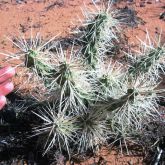Hudson pear
Alert
Have you seen Hudson pear?
Be on the lookout for Hudson pear and report it to Biosecurity Queensland. Early detection and reporting are the key elements in preventing Hudson pear from becoming a major problem in Queensland.
Call us on 13 25 23.

Hudson pear in pot
© Queensland Government

Hudson pear plant
© Queensland Government

Hudson pear flower
© Queensland Government

Hudson pear fruit
© Queensland Government

Hudson pear Lightning Ridge
© Queensland Government

Hudson pear brown-spined plant
© Queensland Government

Hudson pear brown-spined fruit
© Queensland Government

Hudson pear brown-spined flower
© Queensland Government

Hudson pear white-spined plant
© Queensland Government
The name 'Hudson pear' refers to 2 species of thorny cactus native to Mexico: Cylindropuntia rosea and Cylindropuntia tunicata.
Hudson pear is a major invasive plant around Lightning Ridge in New South Wales, where it has formed an extensive wild population. Smaller infestations are found in Western Australia, Northern Territory, South Australia and Queensland. Hudson pear can destroy grazing land and prevent most forms of outdoor recreation, including bushwalking and camping. Hudson pear's reverse-barbed spines can harm wildlife and a single human fatality has been recorded.
You must manage the impacts of Hudson pear on your land.
You must not give away, sell or release Hudson pear into the environment.
You must report all sightings to Biosecurity Queensland within 24 hours.
Scientific name
Other names
- Rosea cactus, thistle cholla, sheathed cholla, cracow pear
Similar species
- C. kleiniae, C. prolifera, C. spinosior
Description
- Densely branched cactus up to 1.5m tall and 3m wide.
- Spines are extremely sharp, 4.5cm long, enclosed in whitish papery sheaths.
- Flowers are pink-purple, 5cm wide.
- Stem segments are green to grey-green, cylindrical, 90cm long, 4cm wide.
- Fruit is oval-shaped, up to 4.5cm long, yellow when ripe.
Habitat
- Prefers semi-arid and arid rangeland in subtropical areas.
Distribution
- Scattered infestations found in Queensland.
Life cycle
- Hudson pear can spread by seed or vegetatively.
Affected animals
- Native animals
- Livestock
- Humans
Impacts
Environmental
- Destroys native pastures.
Economic
- Becomes costly and time-consuming to control.
Social
- Sharp spines threaten native animals, bushwalkers and farm animals.
- Spines can penetrate boots and tyres.
How it is spread
- Spread by animals, vehicles and humans.
Prevention
Control
Call 13 25 23 if you find a plant you suspect may be Hudson pear to seek advice on control options.
Legal requirements
- Hudson pear is a category 2, 3, 4 and 5 restricted invasive plant under the Biosecurity Act 2014.
- You must not give away, sell or release Hudson pear into the environment. Penalties may apply.
- All sightings of Hudson pear must be reported to Biosecurity Queensland within 24 hours of the sighting.
- At a local level, each local government must have a biosecurity plan that covers invasive plants in its area. This plan may include actions to be taken on Hudson pear. Some of these actions may be required under local laws. Contact your local government for more information.